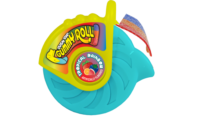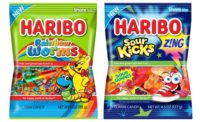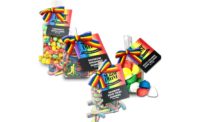M&M’sand Smarties would be virtually unrecognizable without it, and sans this one tiny aspect of candy, you wouldn’t be able to tell what flavor gummy bear or jelly bean you just popped into your mouth.
Color — it’s everything. With more products emerging in different shades and dyes, color continues to be one of the most crucial aspects of a piece of candy. At the same time, it’s becoming one of the most controversial.
Today, different types of confections compete in the market not just in terms of flavor, but also in terms of being the most appealing, the coolest-looking and the most eye-catching.
According to a 2012 National Confectioners Association report, when consumers were asked to name a reason they enjoy gummy candy, their number two answer was short and simple, “It’s fun.” And, one of the easiest ways to add fun and entertainment to a product is through color.
“Color adds glitz to the product,” says David Hibbs, director of business development at Chefmaster, a company that supplies both artificial and natural food colorings. “It really designates how people perceive products.”
Stain on health?
Anyone who knows the candy and confectionery industry knows we live in a very bright and colorful world. For proof, look no further than Skittles’ motto, “taste the rainbow” — but what exactly does this rainbow of colors entail?
For one, it hasn’t all been sunshine and pots of gold for the food coloring industry. Since the 1970s, artificial food colorings have come under fire for allegedly causing a slew of diseases and conditions, such as hyperactivity in children and cancer in adults.
Most of the scientific backing for these claims comes from studies conducted in the 1970s, and especially from a 2007 study from Southampton University in the UK, in which scientists concluded there was a link between increased levels of hyperactivity in young children and the consumption of artificial food colors.
The world started taking notice in July 2010 when a European Union initiative designated that products containing any of six artificial food dyes had to sport labels indicating that the food “may have an adverse effect on activity and attention in children.”
Some in Europe have taken the movement even further — in Britain, Fanta orange soda is dyed with pumpkin and carrot extract while the U.S. version is dyed with Red 40 and Yellow 6, both manufactured from petroleum. Meanwhile, Kellogg’s strawberry NutriGrain bars are colored with the artificial dyes Red 40, Yellow 6 and Blue 1 in the United States, but with beetroot, annatto and paprika extract in the UK.
In the United States, although the Food and Drug Administration (FDA) has always maintained a strong stance on the safety of artificial food colorings, individual states have been initiating changes.
In early 2012, California upheld a state consumer protection law that deemed the amount of 4-Mel — which the state regards as a cancerous substance — in caramel coloring in soda dangerous. For The Coca-Cola Co., that meant either placing a ‘cancer warning’ label on its sodas or reformulating their products. Of course, it chose the latter.
Although no hard stance has been taken on food colorings by the FDA, there has been a push by some confectioners who say that despite the lack of hard evidence, it’s better to be safe than sorry.
“Ultimately the consumer wants the natural, healthy product,” says Amir Frydman, owner of Tree Hugger Gum, an all-natural gum company. “Would you rather have a red chemical food coloring that has ingredients that we’re not familiar with, or would you rather use red beet, which you know the source of?”
Brand perception
Food colorings seem to be stuck in a limbo of health adversity, but while it may not be true that artificial food colorings are dangerous, it is a fact that color plays a crucial role in flavor perception.
For many, purple has always traditionally signaled that a product will probably taste like grapes, yellow like lemons and orange, like, well, oranges. Because color is so prevalent in everything we eat, removing it can affect the taste experience.
“People have been conditioned to perceive certain color association with certain flavors,” says Hibbs. “If someone got a red color and it tasted like chocolate, the perception would not be chocolate.”
And should there ever be a need for a solution, it will prove a lot more difficult than just removing color completely. As it turns out, the way a product is colored can affect sales.
For example, when Heinz introduced EZ Squirt ketchup in October 2000, the product came in colors like green, purple, pink, orange, teal, and blue — all colors achieved through the addition of food colorings. After poor sales, Heinz discontinued the product six years later.
“It’s important that the brand recognition be upheld in all manners, whether it was a brand that was introduced without color and the customer liked the taste profile or whatever feature,” says Hibbs. “[Companies] have to keep those features traditional.”
Food color profile: cochineal extract
The other problem is that even natural food colorings aren’t free from controversy.
In early 2012, Starbucks came under fire for using cochineal extract in some of its products, including its “strawberries & crème” frappuccino blended beverage, strawberry banana smoothie, and birthday cake pop.
Cochineal, also known as carmine, is a natural red dye extracted from the cochineal insect, widely cultivated on cacti.
The coffee chain then announced it was planning to exchange the cochineal extract for lycopene, a natural, tomato-based extract, in all products by June.
But cochineal is a commonly used ingredient and more importantly, is an FDA-approved colorant found in a wide variety of food and beverage products in the United States.
“What’s the difference between a beetle body and taking something out of a plant?” says Hibbs. “Is the body the difference? It’s the same extraction process, but [people] put it out there as if ‘this is an insect body.’”
But, well, using insect products might make a difference.
It turns out that this could be bad news for people with allergies and asthma.
An average of eight insect parts are found in a chocolate bar and deemed safe, according to the FDA’s guidelines. In other words, anything less than 60 insect pieces per 100 grams of chocolate is accepted by the FDA.
For consumers allergic to certain insects, these creepy crawlies can cause side effects such as migraines, cramps, itching, and hives.
With food coloring at the forefront of controversy in the candy world, it remains to be seen what the future holds for the colored confectionery products we know and love. In the meantime, let’s hope the ratio of chocolate:insect remains relatively low and that orange candy will always taste like oranges.






